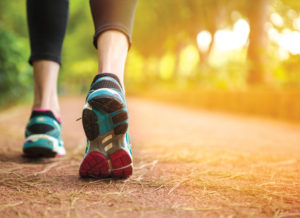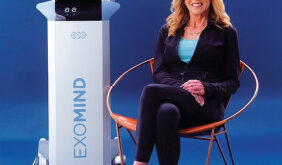Feet and leg problems have a severe impact on quality of life but can easily be prevented by maintaining our secondary hearts.
 Why do so many people suffer from problems with their feet and legs? Swollen feet and ankles, nighttime leg cramps, restless leg syndrome, varicose veins, non-healing lower leg ulcers, loss of sensation in the toes, all are remarkably common among middle-aged and older adults.
Why do so many people suffer from problems with their feet and legs? Swollen feet and ankles, nighttime leg cramps, restless leg syndrome, varicose veins, non-healing lower leg ulcers, loss of sensation in the toes, all are remarkably common among middle-aged and older adults.
Blame our upright posture, gravity, and soft skin. When we are sitting or standing, gravity is pulling the fluids in our body down into our legs. Because our skin is so soft, it stretches, allowing fluid to pool into our feet and legs as long as we continue to sit or stand. Older Americans sit, on average, for over 9 hours a day, while individuals who have desk jobs commonly sit for a total of over 13 hours each day.
FLUID POOLING
Blood pooling into the veins of the legs is one of the most common complications of our sedentary lifestyle and often becomes evident at a relatively young age. Venous pooling first appears as spider veins, then progresses over time to varicose veins. If not corrected, varicose veins can lead to venous insufficiency, a condition that can be very painful, and even dangerous, if it results in the formation of a venous embolism (blood clot).
Fluid pooling into the soft tissues of our legs (muscles, ligaments, tendons, and dermis) results in swollen feet and ankles and can lead to aching joints and nighttime leg cramps. The increased fluid pressure in the feet and legs also constricts blood flow to the nerves causing loss of sensation, typically starting in the toes.
HOW OUR SECONDARY HEARTS
PREVENT FLUID POOLING
What normally prevents fluid pooling into the legs is our “secondary hearts.” The “secondary hearts” are the soleus muscles in the calves of the legs. These specialized muscles collect fluid which pools in the legs and pumps this fluid back up to the heart. The soleus muscles are postural muscles which are generally used to help us maintain a squatting posture. Our ancestors squatted much of the day, and in doing so kept their soleus muscles in good shape. In the modern world, we tend to sit when we rest, and so as we age our soleus muscles lose their pumping ability.
HOW TO RETRAIN YOUR SOLEUS MUSCLES
Fortunately, it is possible to protect your soleus muscles from weakening, or rebuild them if they are failing you. Performing toe-stands throughout the day is very helpful, as is squatting, instead of sitting, and Tai Chi and Yoga can involve substantial use of the soleus muscles.
Of course, postural muscles such as the soleus muscles require several hours per day of exercise to stay in shape, or to rebuild. This can be difficult for many people to fit into their daily routine or sometimes too challenging for older individuals.
Various types of exercise equipment have been developed to assist individuals in rebuilding their soleus muscles. The HeartPartner offered by Sonostics, for example, is a passive-exercise device utilizing technology to activate a reflex which stimulates the soleus muscles into action. It is easy and convenient to use at home or work while sitting in an easy chair, or at a desk or table, for just a few hours over the course of a day. It also allows the individual to keep their socks and shoes on during use.
Feet and leg health complications have a severe impact on quality of life, but such complications can easily be prevented by maintaining our secondary hearts. Whichever secondary heart training strategy you select, make an effort to exercise each day to maintain not only the health of your feet and legs, but whole-body health as well.
“I would highly recommend it. I do think it’s had a positive impact for my initial use of just wanting to downplay my varicose veins and then also with my hands not being cold, it’s been a game-changer.”
Johanna, Endicott NY
Dr. Kenneth J McLeod, Ph.D.
is President and Chief Executive Officer at Sonostics, developer of the HeartPartner. He also serves as Director of the Clinical Science and Engineering Research Center at Binghamton University in New York. Dr. McLeod received his Ph.D degrees in Bio-medical Engineering from the Massachusetts Institute of Technology.
HeartPartner by Sonostics
Toll free: 1-855-696-9283 or visit sonostics.com
Check Also
Physical Therapy for the Brain
Have you noticed you have difficulty hearing your family and friends in a noisy restaurant? …
 South Florida Health and Wellness Magazine Health and Wellness Articles
South Florida Health and Wellness Magazine Health and Wellness Articles




